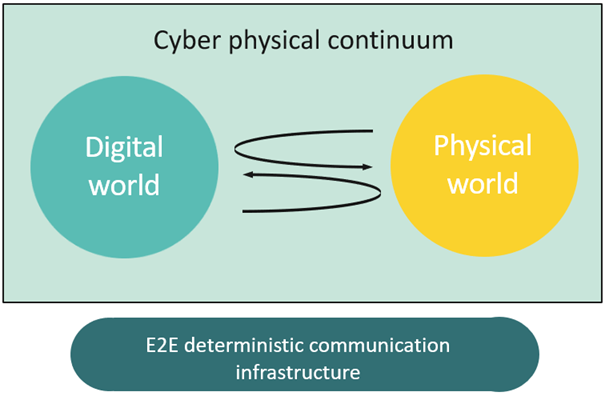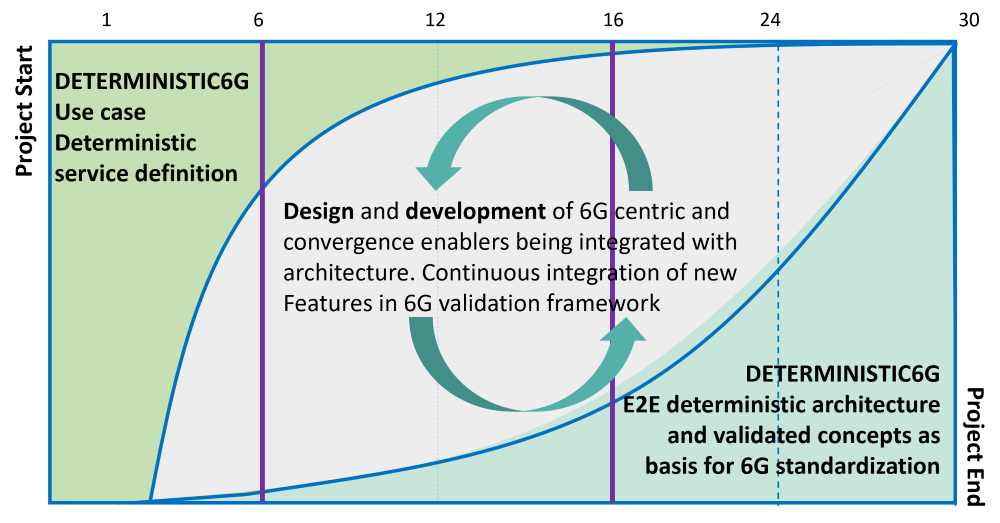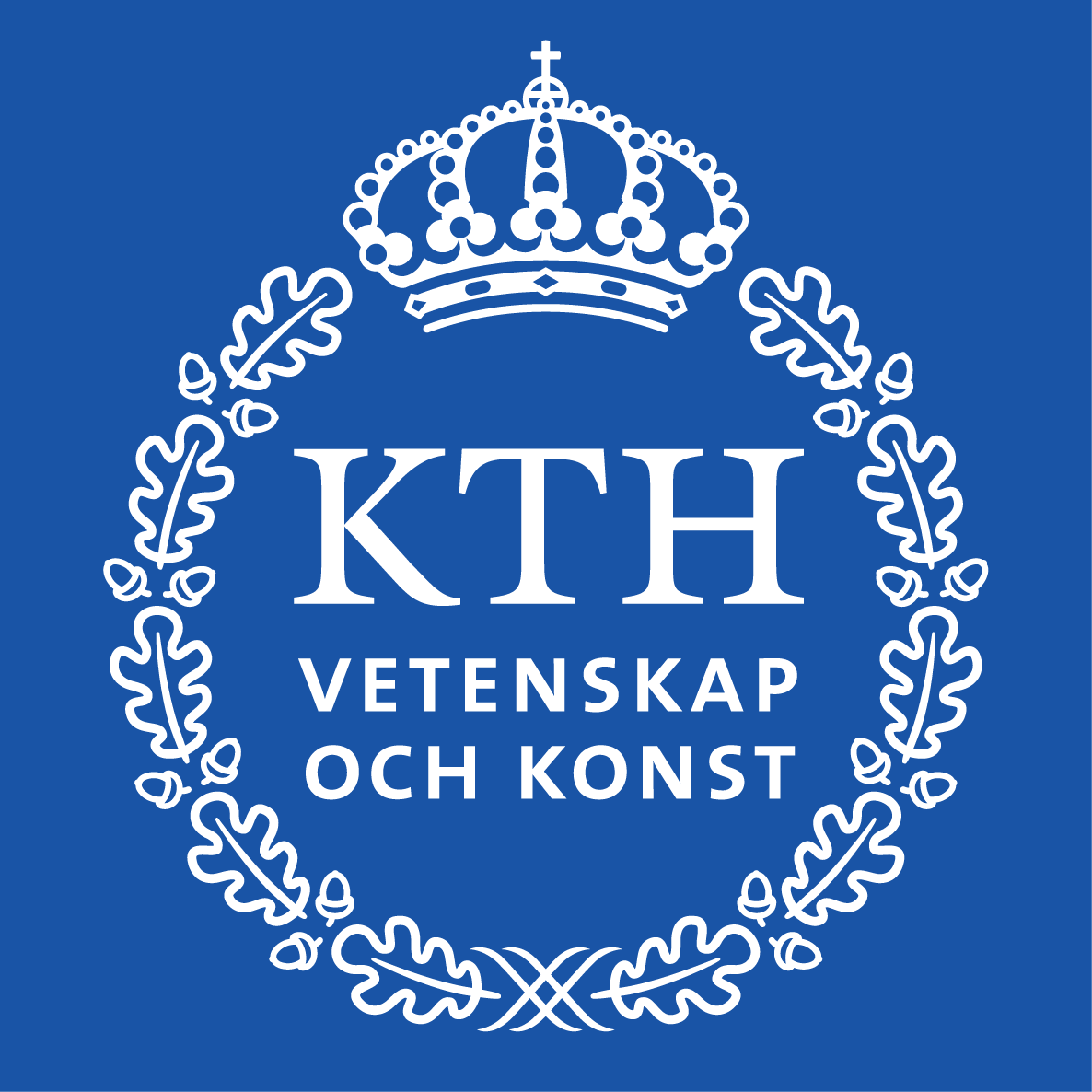Deterministic6G
Deterministic end-to-end communication with 6G
Project facts
| Project start: | 2023-01-01 |
| Duration: | 30 months |
| EU funding: | 5.840.451,00 Euros |
Digitalization is transforming industries and society with the adoption of edge/cloud computing, AI, and digital twins. In the future, physical processes, collaborating machines, but also novel human-system-interactions will move towards a cyber-physical continuum merging the physical world of senses, actions as well as their digital programmable representations. Fundamentally new requirements for deterministic communication with predictable performance will appear for such cyber-physical end-to-end services. Wired deterministic communication standards have already emerged including Time Sensitive Networking (TSN) and Deterministic Networking (DetNet), while 5G has specified mechanisms for interworking with those standards. However, the available support of 5G in conjunction with TSN and DetNet is not sufficient for future end-to-end time-critical applications. Driven by pivotal use cases from Industry 5.0, DETERMINISTIC6G addresses three central challenges of future deterministic end-to-end communication enabled by 6G:
DETERMINISTIC6G will also devise security-by-design for deterministic communication including the integration of edge computing and the support of OPC UA into deterministic network paths. The project targets dissemination of results towards the three essential standardization bodies in this domain: 3GPP (for 6G), IEEE802.1 (for TSN) and IETF (for DetNet). With a strong consortium driving these standards, DETERMINISTIC6G will ensure uptake of the results and insights towards global 6G standards and industry fora.
Our Vision
DETERMINISTIC6G envisions to set the foundation for future global communication standards enabling 6G deterministic communication for visionary use cases.
Digitization is driving the transformation of society and industries. While this journey has already started, it is expected to dramatically accelerate in the 2030 timeframe, as more and more technical enablers mature and spark innovations. Entirely new forms of interaction will appear, between people, between people and machines, and between machines. Immersive communication with extended reality (XR), holographic communication and exchange of human-grade sensory information will make distance disappear. Cloud and edge computing revolutionizes the availability of computing and data storage, enabling digital twins of physical entities and processes creating cyber-physical systems, in which the logic is increasingly moved into the digital domain. At the same time artificial intelligence with data-driven system design opens novel dimensions for analytics and the optimizations of all sorts of processes. These developments are expected to converge towards a cyber-physical continuum, between the connected physical world of senses, actions, experiences, and its programmable digital representations. This development will be especially important in the context of future industrial production systems, one of Europe’s strategic vertical sectors. Recently, the transformation towards Industry 5.0 was initiated, emphasizing the inclusion of humans into the increasingly automated physical processes. This can be achieved through collaborative robotics, tele-operated robotics in hazardous areas, new forms of human-machine-interactions via XR, as well as through physically supporting workers by giving them exoskeletons. These new forms of interaction with cyber, as well as with physical production systems, through virtual and augmented reality will accelerate the evolution of the cyber-physical continuum.

Intelligently networked infrastructures provided through 6G are key to this development, forming the glue that bridges the digital and physical worlds. However, a cyber-physical continuum spanning across several application areas, covering control applications, wearable robotics, or exoskeletons, and XR, is only possible with an underlying deterministic communication infrastructure. Personal wearable equipment, such as occupational exoskeleton (OEs) can reduce the physical load on the human worker. To ensure smooth interworking of OE with humans, demanding requirements are placed on computation and supplicated hardware. Computational offloading offers significantly more efficient implementations of OEs in terms of energyefficiency and costs, accelerating its adoption across various segments of society including manufacturing. This offloading necessitates a new type of deterministic communication behavior which is “end-to-end" (E2E) relevant supporting communications from the sensor through the cyber-physical representation to the actuator. Connectivity paths through the networked infrastructure with unpredictable latency variations directly jeopardize the operations of such applications. These emerging requirements mean that future 6G technology must ensure E2E deterministic communication flows across a multiplicity of heterogeneous domains (i.e., wired, and wireless communication infrastructure, cloud, and applications domains) in single digit milliseconds, and sometimes sub-milliseconds. Such deterministic communication infrastructure will play a vital role in the digitization of the manufacturing sector into a cyber-physical production system in which the entire shopfloors can be modelled, monitored, evaluated, and steered through a digital twin.
Research Challenges
Despite this evolution of TSN, DetNet and 5G, it is important to note that these standards originate from very different system domains. TSN and DetNet are standards originating from the wired communication domain, in which equipment and components have rather stable and predictable performance characteristics. This contrasts to the characteristics of wireless communications. Therefore, the very foundations of these different standards are based on fundamentally different ways of capturing and expressing deterministic vs. stochastic characteristics. This leads to significant challenges in the following areas for which DETERMINISTIC6G will devise novel concepts and solutions.
Architectural aspects for enhanced E2E deterministic communication
- 6G architecture and interfaces allowing dynamic interactions in integrated heterogenous infrastructure (6G-DetCom).
- Convergence with edge computing elements.
- E2E security mechanisms spanning over multiple
heterogeneous infrastructure domains.
Awareness for providing E2E deterministic performance
- New data-driven ML methods for 6G systems
providing probabilistic latency guarantees at run-time
- Efficient implementation of data driven
architecture to ensure latency inferences
- E2E time awareness for supporting the deterministic operations
Anticipation for assurance and control of E2E deterministic performance guarantees
- Algorithms that leverage the information base of 6G digital twins and CPS digital twin in order to maintain E2E guarantees, but also application layer features such as safety.
- Enhancement to application protocol (e.g. OPC UA FX) for requesting and monitoring of deterministic services
Objectives

Objective 1
Definition of deterministic services including KPIs and KVIs for upcoming 6G visionary use cases and mapping of their requirements to network capabilities in mixed wired and wireless time-sensitive topologies
Objective 2
Design and development of 6G features for deterministic wireless transmission and wireless-friendly enhancements for TSN and DetNet
Objective 3
Develop AI/ML based techniques for data-driven latency characterization of 6G wireless systems
Objective 4
Develop 6G time synchronization solution to ensure E2E time awareness and new concepts for deterministic edge cloud solution for compute/communication integration in the 6G system
Objective 5
Conceive a security architecture and framework for 6G deterministic communications
Objective 6
Develop a validation framework for new 6G concepts
Work plan
DETERMINISTIC6G adopts the top-down methodology with the continuous integration approach
Three major work phases are planned.
Phase 1 (M1-M6): Deterministic service definitions along with KPI, KVIs of the use cases necessary for development of technology enablers are defined. Architectural principles considered for development of the deterministic communication architecture are defined. Also, development of the 6G centric and convergence enablers is initiated.
Phase 2 (M7-16): First DETERMINISTIC6G architecture is defined and initial technology enablers pertaining to 6G centric, and convergence are defined.
Phase 3 (M17-30): Final solution for the technology enablers with final DETERMINISTIC6G architecture and validation of the selected key features will be finalized.

The main objective of each work package (WP) is briefly described below.
WP1 sets the basis for technical concept developments of DETERMINISTIC6G project by defining 6G use cases, architectural aspect, defining KPIs and KVIs and security analysis.
WP2 focuses on the development of 6G centric enablers for ensuring deterministic communication services. Concept pertaining to 6G deterministic wireless design concept, data-driven techniques and time synchronization solution will be investigated. WP2 will take input in terms of the requirements from WP1 and will provide insights towards architecture work within WP1. WP2 also intends to provide input to validation work within WP4.
WP3 focuses on the development of new concepts and investigates the features in the direction of 6G convergence with edge computing, deterministic communication standard and situational awareness enabled by interaction with cyber-physical digital twins.
WP4 develops a 6G validation framework specific for deterministic communication following the methodology proposed in Section 1. Selected new features from WP2 and WP3 will be validated against the use case and deployment scenario developed within WP1.
WP5 ensures the project creates societal, technological, and economic impact.
WP6 ensures smooth operation of the whole project. Main activities include technical and project coordination across the whole project.














